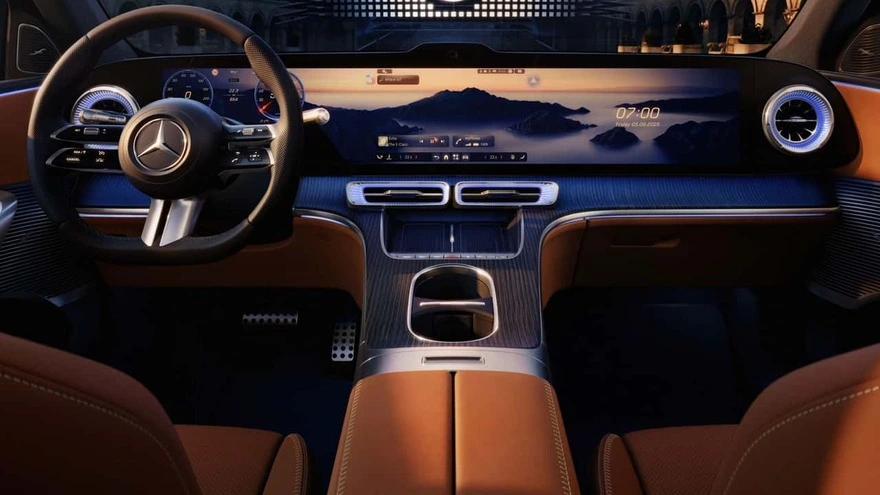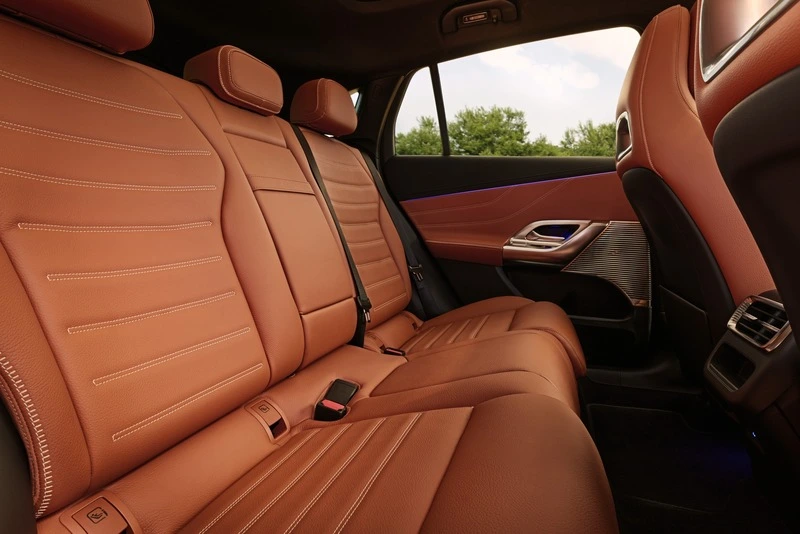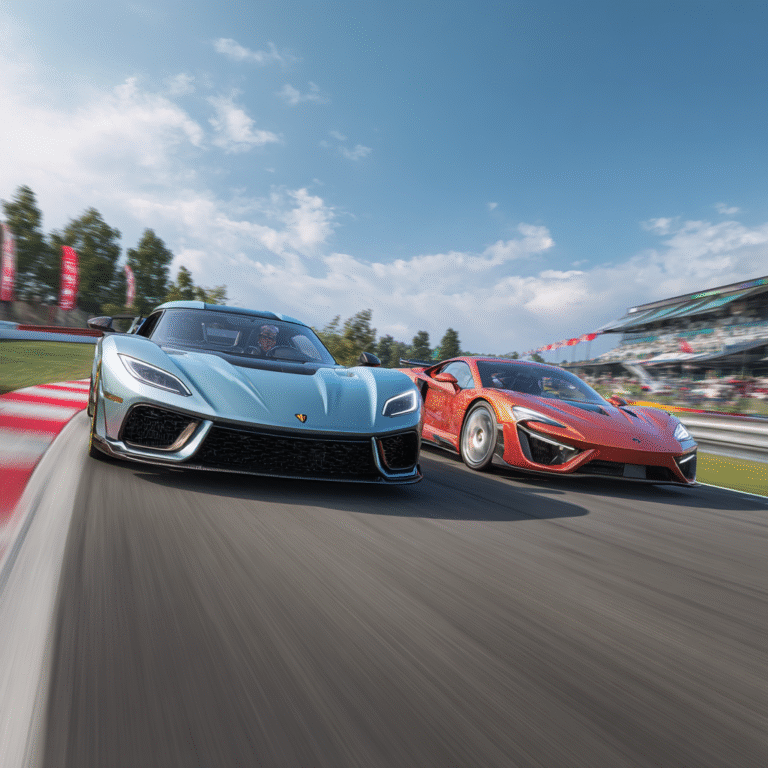Introduction
Mercedes-Benz has officially unveiled its most ambitious electric vehicle project yet: the all-new GLC with EQ Technology. This groundbreaking electric SUV represents a complete reimagining of Mercedes’ best-selling compact luxury crossover, delivering an impressive combination of up to 440 miles of range, cutting-edge AI integration, and revolutionary display technology that sets new standards for the luxury electric vehicle segment.
The Mercedes-Benz GLC with EQ Technology arrives at a pivotal moment in the automotive industry’s electric transformation. As luxury automakers race to electrify their most popular models, Mercedes has chosen to completely reinvent rather than simply adapt, creating what may become the definitive electric luxury SUV for the mid-2020s market.
The End of an Era: From EQC to GLC with EQ Technology
Learning from the EQC’s Market Performance
The story of Mercedes’ electric GLC begins with understanding the shortcomings of its predecessor, the EQC. Based on the combustion-powered GLC, the EQC featured an electric drive system, a closed black grille and rounded design – setting the tone for upcoming EVs until 2025. However, the EQC was not a great success, and after only around four years of production, it was discontinued in spring 2023.
The EQC’s market challenges provided valuable lessons that Mercedes has applied to this new approach. Rather than creating a separate EQ-branded vehicle, Mercedes has chosen to integrate electric technology directly into their most successful SUV platform, ensuring broader market appeal and manufacturing efficiency.
A New Naming Strategy with Purpose
Instead of a second-generation EQC, this is the GLC with EQ Technology, an admittedly inelegant name that nevertheless captures what the mission is: deliver an electric take on Mercedes’s best-seller, the GLC compact luxury crossover. This naming convention signals Mercedes’ commitment to offering both electric and conventional powertrains within the same model line, providing consumers with genuine choice while maintaining brand coherence.
The naming strategy also reflects Mercedes’ evolving approach to electrification, moving away from separate EQ sub-brands toward integrated electric options across their entire lineup. This approach eliminates the artificial separation between electric and conventional vehicles, treating electrification as a powertrain option rather than a completely different product category.
Revolutionary Performance Specifications
Impressive Power and Range Capabilities
Mercedes-Benz introduces the new GLC with EQ Technology, which packs a 94.0-kilowatt-hour battery with up to 483 horsepower. These specifications immediately place the electric GLC among the most powerful vehicles in its segment, offering performance that exceeds many traditional luxury performance SUVs while delivering the instant torque characteristics that make electric drivetrains so compelling.
The 483-horsepower output represents a significant increase over the previous EQC’s power levels, demonstrating Mercedes’ commitment to making their electric vehicles genuinely exciting to drive rather than merely efficient alternatives to conventional powertrains.
Advanced Battery Technology and Charging
The 800V technology means the battery can be charged at a rate of 320kW 10 minutes will deliver enough for around 160 miles of driving. The battery pack is 94.5kWh, which should offer a range in the region of around 400 miles, although smaller packs will also be available.
The implementation of 800-volt architecture represents a significant technological advancement that addresses one of the primary concerns about electric vehicle ownership: charging time. The ability to add 160 miles of range in just 10 minutes transforms long-distance travel capabilities and makes the electric GLC genuinely practical for extended journeys.
This charging speed places Mercedes at the forefront of electric vehicle technology, matching or exceeding the charging capabilities of purpose-built electric vehicle platforms from companies like Porsche and Genesis. The availability of smaller battery packs suggests Mercedes recognizes that different customers have varying range requirements and price sensitivities.
Cutting-Edge Technology Integration
Multi-Agent AI System Revolution
Many EVs offer some form of AI. But Mercedes’ newest model offers AI assistance from ChatGPT, Bing, Google Gemini and Mercedes’ own system all in the same car. This unprecedented integration of multiple AI platforms creates a truly intelligent vehicle interface that can handle complex queries, provide comprehensive information, and adapt to individual user preferences in ways that single-platform systems cannot match.
The multi-agent approach represents a fundamental shift in automotive AI implementation. Rather than forcing users to adapt to a single AI personality or capability set, Mercedes allows the system to leverage the strengths of different AI platforms depending on the specific task or query type. This approach ensures that users receive the most appropriate and accurate responses regardless of their information needs.
Revolutionary Display Technology
The Mercedes GLC with EQ Technology gets a massive 39.1-inch display, covering the entire upper part of the dashboard. The cabin still has a handful of buttons. This enormous display represents one of the largest single-screen implementations in any production vehicle, creating an immersive digital environment that transforms the traditional automotive interior concept.

The 39.1-inch display serves multiple functions simultaneously, providing navigation information, vehicle controls, entertainment options, and AI interface access through a single, cohesive interface. The retention of physical buttons for essential functions demonstrates Mercedes’ understanding that complete digitization can compromise safety and usability in certain driving situations.
This display technology creates new possibilities for passenger engagement and vehicle customization. The massive screen real estate allows for multiple applications to run simultaneously, enabling passengers to access different functions without interfering with driver-focused information.
Advanced All-Wheel Drive System
Intelligent Torque Distribution
To ensure optimal traction and driving stability on snow and ice, sensors detect spinning wheels and distribute torque according to the operating strategy. Since both electric motors are controlled independently, the driving force remains optimally maintained.
The dual-motor all-wheel-drive system represents a significant advancement over traditional mechanical all-wheel-drive systems. The ability to control each axle independently allows for precise torque vectoring that improves both performance and safety in challenging driving conditions.
This system proves particularly valuable in winter driving conditions, where traditional all-wheel-drive systems often struggle to maintain optimal traction. The instantaneous response of electric motors allows for real-time adjustments that mechanical systems cannot match, providing superior control and confidence in adverse conditions.
Performance-Oriented Driving Dynamics
The independent motor control system also enables performance driving capabilities that exceed what mechanical systems can achieve. By varying torque distribution between front and rear axles, the system can optimize handling characteristics for different driving situations, from maximum acceleration to precise cornering control.
This technology represents a fundamental advantage of electric drivetrains over conventional powertrains. The ability to instantly vary power delivery to individual wheels creates opportunities for dynamic vehicle behavior that traditional drivetrains cannot replicate.
Market Positioning and Competition
Direct BMW iX3 Challenger
That means it’ll go right against the new BMW iX3, positioning the Mercedes GLC with EQ Technology as a direct competitor to BMW’s electric SUV strategy. This competition represents a crucial battle for luxury electric SUV market leadership, with both German automakers leveraging their traditional strengths while adapting to electric vehicle requirements.
The competition with BMW’s iX3 extends beyond mere specifications to encompass brand philosophy, technology integration, and customer experience approaches. Mercedes’ choice to integrate AI systems from multiple providers contrasts with BMW’s more proprietary approach, potentially offering users more flexibility and capability.
Luxury Electric SUV Segment Leadership
The electric GLC’s specifications and technology features position it to compete effectively against established luxury electric SUVs like the Tesla Model Y Performance, Genesis GV70 Electrified, and upcoming electric offerings from Audi and other luxury manufacturers.
Mercedes’ traditional strengths in luxury appointments, build quality, and brand prestige provide significant advantages in this competitive segment. The combination of impressive range, rapid charging, and advanced technology creates a compelling package that addresses the primary concerns that have limited luxury electric SUV adoption.
Manufacturing and Production Strategy
Parallel Production Approach
The electric GLC is a new vehicle, but it’ll be offered alongside the internal combustion model introduced in 2022. This parallel production strategy allows Mercedes to serve both electric and conventional vehicle customers while transitioning manufacturing capacity gradually as market demand evolves.
The ability to produce both electric and conventional versions of the GLC provides Mercedes with flexibility to respond to market conditions, regulatory requirements, and customer preferences without committing exclusively to either powertrain technology. This approach reduces financial risk while maintaining maximum market coverage.
Global Market Rollout Plans
The production strategy suggests that Mercedes intends to make the electric GLC available across multiple global markets simultaneously, rather than limiting initial availability to specific regions. This approach reflects Mercedes’ confidence in the vehicle’s market appeal and their commitment to electric vehicle leadership.
Interior Design and User Experience
Luxury Meets Technology
The interior design of the GLC with EQ Technology represents a careful balance between Mercedes’ traditional luxury values and cutting-edge technology integration. The massive display dominates the visual experience while maintaining the premium materials and craftsmanship that Mercedes customers expect.

The interior space optimization benefits from the electric drivetrain architecture, which eliminates the transmission tunnel and allows for more efficient space utilization. This creates additional storage opportunities and improved passenger comfort compared to conventional GLC models.
Advanced Comfort and Convenience Features
Mercedes has integrated advanced climate control systems that pre-condition the vehicle while connected to charging infrastructure, ensuring optimal cabin temperature without impacting driving range. The electric drivetrain also enables sophisticated sound management, creating an exceptionally quiet cabin environment that enhances the luxury experience.
The integration of multiple AI systems extends to personalization features that learn individual user preferences for climate, seating position, infotainment settings, and route preferences. This creates a truly personalized vehicle experience that adapts to different drivers and passengers automatically.
Environmental Impact and Sustainability
Carbon Neutral Manufacturing Goals
Mercedes-Benz has committed to carbon-neutral manufacturing for the GLC with EQ Technology, implementing renewable energy sources, sustainable materials, and efficient production processes throughout the manufacturing cycle. This commitment extends beyond the vehicle itself to encompass the entire production and supply chain.
The battery technology incorporates sustainable sourcing practices for rare earth materials and includes plans for battery recycling and second-life applications. These initiatives address growing consumer concerns about the environmental impact of electric vehicle battery production and disposal.
Lifecycle Environmental Benefits
The electric GLC’s environmental benefits extend throughout its operational lifetime, with zero direct emissions and significantly reduced total environmental impact compared to conventional vehicles. The 94.5kWh battery capacity provides sufficient range for most users’ daily needs while minimizing charging frequency and infrastructure demands.
Pricing Strategy and Market Positioning
Premium Pricing for Premium Features
While Mercedes has not officially announced pricing for the GLC with EQ Technology, industry analysts expect the vehicle to command a premium over conventional GLC models, reflecting the advanced technology, superior performance, and extensive feature content.
The pricing strategy must balance premium positioning with competitive necessity, as luxury electric SUVs face increasing competition from both traditional luxury manufacturers and electric vehicle specialists. Mercedes’ brand equity and technology leadership provide justification for premium pricing, but market success will ultimately depend on delivering exceptional value relative to competitors.
Value Proposition Analysis
The GLC with EQ Technology offers compelling value through its combination of impressive range, rapid charging capability, advanced AI integration, and luxury appointments. The 440-mile range capability addresses range anxiety concerns while the 320kW charging capability minimizes charging inconvenience for long-distance travel.
The multi-agent AI system and massive display technology provide unique capabilities that differentiate the vehicle from competitors, potentially justifying premium pricing through superior user experience and technological advancement.
Future Implications for Mercedes-Benz
Electric Vehicle Strategy Evolution
The GLC with EQ Technology represents a crucial milestone in Mercedes-Benz’s electric vehicle strategy, demonstrating their ability to create genuinely competitive electric vehicles that maintain the luxury and performance characteristics that define the brand.
The 2026 Mercedes-Benz GLC with EQ Technology, to give it its full name, is thus a milestone vehicle, the first of a new generation of pure EVs from Mercedes-Benz that promise more performance, more range, and more computer power.
This milestone status suggests that Mercedes views the electric GLC as a template for future electric vehicle development, potentially influencing design and technology choices across their entire electric vehicle lineup.
Technology Platform Expansion
The advanced technologies introduced in the GLC with EQ Technology, including the 800V architecture, multi-agent AI system, and massive display integration, will likely appear in other Mercedes electric vehicles, creating economies of scale and consistent user experiences across the brand’s electric portfolio.
The success of these technologies in the GLC market will influence Mercedes’ future investment priorities and development focus, potentially accelerating the adoption of similar features across their vehicle lineup.
Consumer Adoption Challenges and Opportunities
Infrastructure Requirements
The GLC’s 320kW charging capability requires access to high-powered charging infrastructure that remains limited in many markets. Mercedes must work with charging network operators to ensure adequate infrastructure availability in target markets to realize the vehicle’s full potential.
The 440-mile range capability reduces dependence on public charging infrastructure for daily use, but long-distance travel still requires reliable access to high-power charging stations. Mercedes’ success will partly depend on the expansion of compatible charging networks.
Technology Adoption Curves
The advanced AI integration and massive display technology may require customer education and adaptation periods, particularly for traditional Mercedes customers who may be unfamiliar with such extensive technology integration.
Mercedes must balance technological advancement with user accessibility, ensuring that new technologies enhance rather than complicate the ownership experience. The retention of some physical controls suggests awareness of this challenge.
Conclusion: Redefining Electric Luxury
The Mercedes-Benz GLC with EQ Technology represents a comprehensive reimagining of what luxury electric SUVs can achieve. By combining impressive performance specifications, cutting-edge technology integration, and traditional Mercedes luxury values, the vehicle addresses virtually every concern that has limited electric vehicle adoption among luxury car buyers.
The 440-mile range capability eliminates range anxiety, the 320kW charging capability minimizes charging inconvenience, and the multi-agent AI system provides unprecedented intelligent assistance. The massive 39.1-inch display creates an immersive digital environment while maintaining essential physical controls for safety and usability.
Perhaps most significantly, the GLC with EQ Technology proves that electric vehicles need not compromise on luxury, performance, or advanced technology. Instead, electrification enables capabilities that conventional powertrains cannot match, from instant torque delivery to sophisticated energy management and intelligent vehicle behavior.
As the automotive industry continues its electric transformation, the Mercedes GLC with EQ Technology establishes new benchmarks for what consumers can expect from luxury electric vehicles. The combination of advanced technology, impressive performance, and traditional Mercedes values creates a compelling package that may well define the next generation of electric luxury SUVs.
For Mercedes-Benz, this vehicle represents both validation of their electric vehicle strategy and a foundation for future development. The technologies and approaches pioneered in the GLC with EQ Technology will likely influence the brand’s entire electric portfolio, establishing Mercedes as a serious competitor in the premium electric vehicle segment.
The success of the GLC with EQ Technology will be measured not just in sales numbers but in its ability to convince luxury car buyers that electric vehicles can exceed rather than merely match the capabilities of conventional alternatives. Early indications suggest that Mercedes has created a vehicle capable of achieving both objectives, potentially accelerating the luxury segment’s transition to electrification.
The Mercedes-Benz GLC with EQ Technology is expected to arrive in showrooms in 2026, with pricing and final specifications to be announced closer to the launch date.



